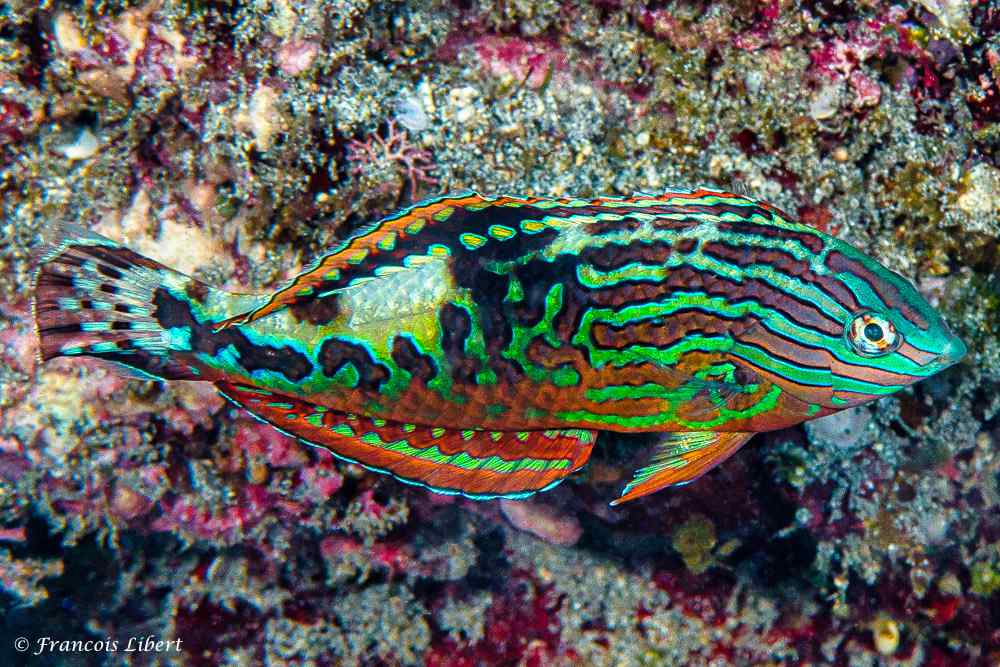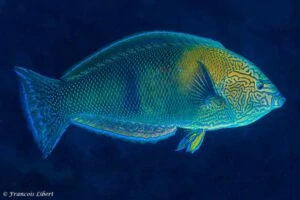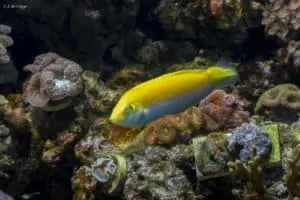Macropharyngodon bipartitus – Blue Star Wrasse
Macropharyngodon bipartitus was described by Smith in 1957. The name Macropharyngodon bipartitus is derived from Greek words. The first part comes from “makros” which means “great”. And this fish certainly is. The most used common name is Blue Star Wrasse. Other names are Peacock Leopard Wrasse, African Leopard Wrasse, Vermiculite Wrasse or Divided Wrasse.
Description
The Blue Star Wrasse, like many other wrasses, is born as a female and look identical. Really beautifully coloured. They are orange-red with greenish and yellow spots (rimmed with blue and black). The head is speckled and streaked. They live in a group together.
When the male dies, the dominant female will then transform into the male sex. They also get completely different patterns and colours. This colour and sex change can last up to 4 years in the aquarium and almost only happens if several specimens live in the aquarium (pairing).
The male is also truly beautiful to look at. The basic colour of the male Blue Star Wrasse is white to green with irregular black spots. The older the male is, the darker the colours become.
Some say that the Macropharyngodon bipartitus males live solo and only seek out a female during mating season, but in other books, one can read that the females stay with the male like a harem. The male is about 13-15 cm long, the female is usually a bit smaller.

Origin
Macropharyngodon bipartitus is native to a fairly extensive area; it can be found both in the Indian Ocean, near the Cocos Islands, which lie southwest halfway between Australia and Sri Lanka, the Pacific Ocean, near the islands of Oceania, the collective name for many islands in the Great or Pacific Ocean and in the Red Sea.
It is mainly located at a depth of 2 to 30 meters near the shelter of reefs. Usually in areas with sand, rubble and coral. The temperature of the water fluctuates
between 24 °C – 28 °C.
Diet
They are lively fish that continuously swim through the tank in search of micro-organisms for food. This is not sufficient, so they should be fed additionally with brine shrimp and similar food. Macropharyngodon bipartitus have a small mouth, so keep this in mind with the size of the food.
The Blue Star Wrasse is a somewhat more difficult fish. They often have trouble getting used to aquarium conditions. Food is also a problem with some specimens. Some fish find it difficult to get used to frozen food. An attempt can be made to give live food first and gradually switch to frozen food. If the fish successfully adapts to the circumstances and therefore also accepts good replacement food, the fish can be kept well.

The Aquarium
The aquarium for one or two of these fish should contain at least 200 litres. It is better to keep one male with three females. But a larger group is much nicer so that the natural composition is better imitated. The aquarium really needs to be a lot bigger for this.
The water, almost like where they come from, should have a temperature of between 23-26 °C.
This fish sleeps and hides in the sandy bottom so it must be thick enough for this. A layer
of 7 centimetres is a good guideline. Because sand is often moved during digging, this fish is not an ideal combination with sensitive corals that lie on the sandy bottom. If these corals often get sand on them, they tend to stay closed or risk getting damaged. This can eventually lead to the death of the coral. For leather corals, this is less of a problem than for stony corals.
When purchasing this species, pay close attention to whether they eat. Fish suffer from stress when catching and transporting them. This species is somewhat sensitive to that. The combination with overly aggressive fish is also not recommended. The Blue Star Wrasse can be described as a softy.
Even though this fish is unfortunately not very easy to keep, it is definitely worth it for the experienced marine aquarist. Because who wouldn’t want such beauty in their marine aquarium?
Video
Author
Margie van der Heijden – Ons Natuurgenot Gouda
Copyright images
Francois Libert (Zsispeo) – CC BY-NC-SA 2.0
Margie van der Heijden – Ons Natuurgenot Gouda















Reviews
There are no reviews yet.